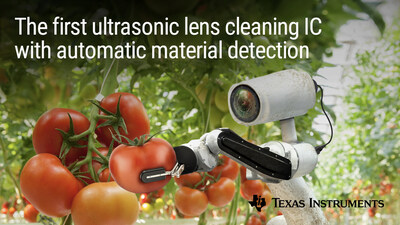Industry's first ultrasonic lens cleaning chipset enables self-cleaning cameras and sensors
Texas Instruments (NASDAQ: TXN) has unveiled the industry's first purpose-built semiconductor technology designed for ultrasonic lens cleaning (ULC). The new chipset, including the ULC1001 DSP and DRV2901 piezo transducer driver, facilitates automatic detection and removal of contaminants on camera lenses through microscopic vibrations. This innovation enhances system reliability, reduces maintenance needs, and is adaptable across various camera applications, from automotive to smart cities. The ULC1001 DSP is priced at $6.43, while the DRV2901 is available for $5.35, promoting cost-effectiveness in self-cleaning camera systems.
- Introduction of the ULC chipset could revolutionize self-cleaning camera technology, reducing downtime and maintenance costs.
- The ULC1001 DSP and DRV2901 driver enable a compact and integrated solution, improving system reliability across various applications.
- None.
Insights
Analyzing...
Removing contaminants from camera lenses traditionally requires manual cleaning, causing system downtime, or the use of various mechanical parts that could malfunction. TI's new ULC chipset, including the ULC1001 digital signal processor (DSP) and companion DRV2901 piezo transducer driver, features a proprietary technology that allows cameras to rapidly self-clear contaminants using precisely controlled vibrations to rapidly eliminate debris, which improves system accuracy and reduces maintenance requirements. The chipset offers designers a compact and affordable way to use ULC in a wide range of applications and camera sizes. For more information, see www.ti.com/ulc1001-pr and www.ti.com/drv2901-pr.
"ULC can make widespread use of self-cleaning cameras and sensors a reality. Existing cleaning approaches are expensive and impractical, requiring complicated mechanics, costly electronics and significant processing to detect contaminants and execute cleaning," said
The ULC1001 controller includes proprietary algorithms for automatic sensing, cleaning, and temperature and fault detection without any image processing, making ULC technology highly adaptable to various camera lens designs. The chipset's small form factor makes it possible to improve machine vision and sensing in a variety of applications – any place that a camera or sensor could get dirty. To learn how it works, read the technical article, "Ultrasonic Lens Cleaning: A Solid-State Technology You Didn't Know You Needed."
"As advanced driver assistance systems [ADAS] become more sophisticated and drivers rely on them more extensively, it will become more important than ever that the sensor suite is fully operational at all times," said
Reduce system size and complexity with an integrated solution
TI's ULC chipset eliminates the need for complex mechanical parts and human intervention in lens cleaning systems. The ULC1001 ultrasonic cleaning DSP with proprietary algorithms integrates a pulse-width modulator, current- and voltage-sense amplifiers and an analog-to-digital converter. Used together with the DRV2901 piezo transducer driver as a companion amplifier, TI's chipset enables ULC in a compact footprint with a printed circuit board size less than 25 mm by 15 mm, reducing the bill of materials while providing more functionality than a discrete implementation.
Package, availability and pricing
The ULC1001 DSP is in volume production and available for purchase on TI.com and authorized distributors in a 4.5-mm-by-5-mm, 32-pin HotRod™ quad flat no-lead (QFN) package, with pricing at
About
Trademarks
All registered trademarks and other trademarks belong to their respective owners.
![]() View original content to download multimedia:https://www.prnewswire.com/news-releases/industrys-first-ultrasonic-lens-cleaning-chipset-enables-self-cleaning-cameras-and-sensors-301723493.html
View original content to download multimedia:https://www.prnewswire.com/news-releases/industrys-first-ultrasonic-lens-cleaning-chipset-enables-self-cleaning-cameras-and-sensors-301723493.html
SOURCE









